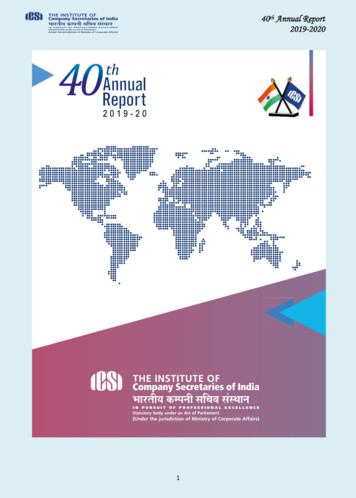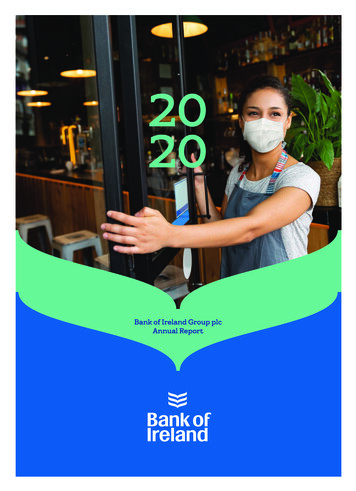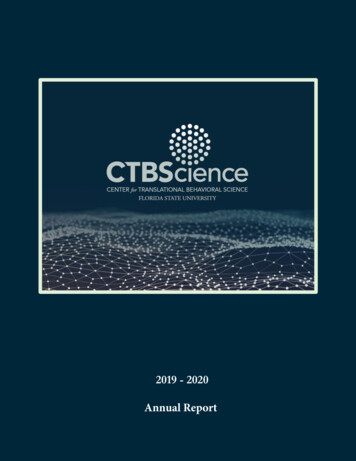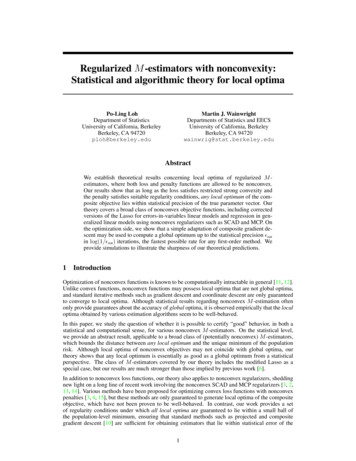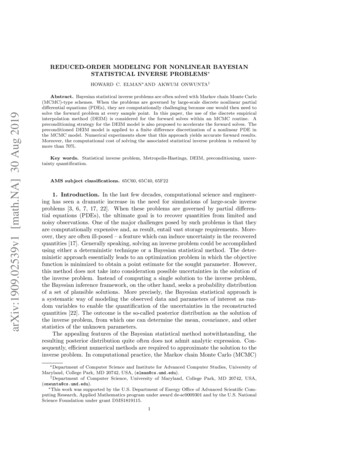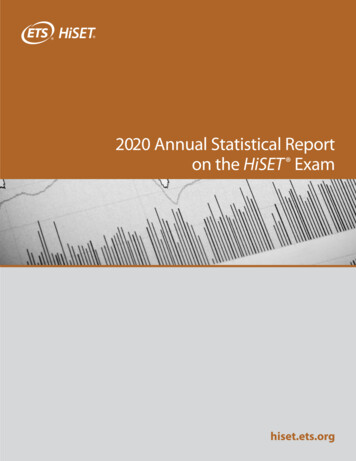
Transcription
2020 Annual Statistical Reporton the HiSET Examhiset.ets.org
Table of ContentsAbout HiSETAbout ETS .1About ITP .1Test Content .1OverviewThe HiSET Tests.2Table 1. Number of Test Items and Time Limits.2Scoring the HiSET Tests.2Explanation of the Scaled Scores.3Samples Reported.3HiSET Annual ReportThe Standard Setting.4Table 2a. Examinees Who Took and Passed Individual Tests.5Table 2b. Examinees Who Took and Passed Individual Tests in Spanish.7Table 3a. Number of Examinees Tested and Number of Batteries Completed in 2020.8 Table 3b. Number of Examinees Tested in Spanish and Number of Batteries Completedin Spanish in 2020.9Table 4a. Batteries Completed and Passed in 2020. 10Table 4b. Batteries Completed in Spanish and Passed in Spanish in 2020. 12 Table 5. Means, Standard Deviations, and Percentage of Examinees by Age Group,by States, and Total. 14Table 6. Percentage of Examinees by Gender, by States, and Total. 15Table 7. Completers with Reported Hispanic Background. 16Table 8. Completers with Reported Race by States and Total. 17Table 9. Completers with Reported Education Level by States and Total. 18Table 10. Completers with Reported Mother’s Education Level by States and Total. 19Table 11. Completers with Reported Father’s Education Level by States and Total. 20Table 12. Completers with Reported Employment Status by States and Total. 21Table 13. Completers with Reported Reasons for Taking the Test by States and Total. 22Table 14. Completers with Reported Ways of Preparing for the Test by States and Total. 23
Table 15a. Reading Formats Administered. 24Table 15b. Writing Formats Administered. 25Table 15c. Math Formats Administered. 26Table 15d. Science Formats Administered. 27Table 15e. Social Studies Formats Administered. 28Table 16. Summary Statistics for Individual Tests. 29Table 17. Summary Statistics for Examinees Completing all Five Tests (The Full Battery). 31Table 18. Passers with Reported Reason for Testing. 33Table 19. Summary Statistics for Passers. 34Table 20. Passing Rates by Age. 35Table 21. Passing Rates by Gender. 36Table 22. Passing Rates by Reported Hispanic Background. 37Table 23. Passing Rates by Reported Race. 38Table 24. Year to Year Comparison of Examinees. 39Definitions of Key Terms. 402020 Annual Statistical Report on the HiSET Exam
IntroductionAbout HiSETEducational Testing Service (ETS ) and Iowa Testing Programs (ITP) co-developed the HiSET Program. TheHiSET is an essential part of ETS’s mission to provide innovative and meaningful measurement solutionsthat improve teaching and learning, expand educational opportunities, and inform educational policy.Some individuals who seek a high school credential may lack the opportunity to experience a traditionallystructured high school teaching and learning environment. The HiSET Program seeks to help theseindividuals identify, acquire, and demonstrate the knowledge and skills that they will need to succeed inpostsecondary education and in the workplace.About ETSFounded as a non-profit in 1947, ETS advances quality and equity in education for people worldwide bycreating assessments based on rigorous research. ETS serves individuals, educational institutions, andgovernment agencies by providing customized solutions for teacher certification; English language learning;and elementary, secondary, and postsecondary education — as well as by conducting education research,analysis, and policy studies. ETS develops, administers, and scores more than 50 million tests annually —including the College Board Advanced Placement Program (AP ) exams, the GRE General and SubjectTests, the National Assessment of Educational Progress (NAEP), and the TOEFL and TOEIC tests — in morethan 180 countries, at over 9,000 locations worldwide.About ITPITP is a non-profit research, development, and outreach unit in the College of Education at the University ofIowa. ITP’s mission is to pursue: research that improves the practice of educational measurement design and development of assessments for a variety of purposes and audiences includingeducators; federal, state, and local governments; and academic institutions outreach that delivers assessment results and supports the use of assessment information by local,state, national, and international audiencesTest ContentThe HiSET measures knowledge and skills in five subject areas: Language Arts — Reading, LanguageArts — Writing, Mathematics, Science, and Social Studies.1
OverviewOverviewThe HiSET Program has been in operation since January 2014. This report provides volume and testperformance information for examinees who took the HiSET between January 1, 2020 and December 31,2020. The intent of this report is to help HiSET examinees, score users, and policy makers understand HiSETscores and to encourage appropriate score interpretation and use.The HiSET TestsHiSET examinees test in five content areas: Reading (Language Arts — Reading), Writing (LanguageArts — Writing), Mathematics, Science, and Social Studies. The Test at a Glance documents — which areavailable for download on the HiSET Web site — provide descriptions of the specifications behind currentHiSET forms. Each subject-area test produces a score on a 1 – 20 reporting scale. We used standard settingstudies (Tannenbaum & Reese, 2014) to recommend the minimum test scores (i.e., cut scores) needed forexaminees to be considered qualified enough to earn a high school equivalency certificate. The tests consistof multiple-choice items, except for a direct writing task associated with the Writing test. Table 1 displays thenumber of items and time limits associated with each test.Table 1. Number of Test Items and Time LimitsContent AreaNumber of ItemsNumber of MinutesLanguage Arts — Reading5065Language Arts — Reading (Spanish)508060 essay120Mathematics5590Science6080Social Studies6070Language Arts — WritingScoring the HiSET TestsWith the exception of the essay portion of the Writing test, HiSET item responses receive a score of eithercorrect or incorrect; and the sum of the correct responses becomes the raw score. There is no penaltyfor answering incorrectly. Raw scores on the Mathematics, Reading, Science, and Social Studies tests areconverted directly to scores on the 1 – 20 reporting scale. In Writing, the scaled score from the multiplechoice section is combined with the scaled score on the essay to produce the 1 – 20 reporting scale. Webased the ratings of the essay scores in the Writing test on a 6-point rating scale that ranges from “little or noskill” to “proficient skill.”2020 Annual Statistical Report on the HiSET Exam2
OverviewExplanation of the Scaled ScoresEach of the five tests in the HiSET battery is scored on a scale of 1 – 20. In order to pass, an examinee mustdo all three of the following: achieve a score of at least 8* on each of the five individual tests score at least 2 out of 6 on the essay portion of the Writing test have a total combined score on all five tests of at least 45* Minimum passing score is based on HiSET “pass” cut score requirements. Credential issuing agencies mayset their own requirements. The pass rate data calculated in this report is calculated based on the HiSET“pass” score requirement.Samples ReportedThe samples in this report sometimes refer to examinees who have taken individual tests; and sometimesthe samples refer to examinees who have taken the full battery of tests. All samples unless otherwise notedare composed of both English and Spanish examinees. For battery tables, examinees should have taken allfive tests in Spanish to be considered Spanish completers. Tables which include test-specific information arebased on the sample of examinees that have attempted the specific test. These tables are broken into twotypes of samples: 1) a sample of examinees which details their first attempt to pass a specific test, and 2) asample of examinees which encompasses all of their attempts to pass a specific test. The latter of the twoincludes multiple attempts by some examinees. Tables which include these samples are Tables 2, 3, 15, 16and 24.Tables which include information about the battery consist of only examinees that have completed all fiveindividual HiSET tests — however, completers have not necessarily passed the battery or any individualtest. Instead, a “completer” refers to an examinee that has completed the final test of their battery in 2020.This sample is broken into two subsamples for each individual test: 1) a subsample of first attempts, and 2)a subsample of best attempts (i.e., highest scores). Tables which include these samples are Tables 3, 4, 5, 6,7, 8, 9, 10, 11, 12, 13, 14, 17, 20, 21, 22, 23 and 24. In 2020, there were 24,915 completers. For the purposesof assigning examinees to a state, a completer is considered completed only in the state in which he or shemost recently tested. Tables based on “passers” include those completers who have passed the HiSET batteryon a first attempt. These samples occur in Tables 4, 18, 19, 20, 21, 22, 23 and 24.For certain identifying questions, examinees had the option to expressly indicate that they did not wish toprovide a response, or to simply refrain from responding at all. Response rates reported include those whoexpressly indicated that they did not wish to respond. The percentages for responses reported in the tables,including those who expressly chose not to respond, sum to 100 percent.In addition to the data reported for 2020, trend data comparing 2019, 2018, and 2017 are also included inthis report and summarized in Table 24, which includes number tested, percent completed, and percentpassing for 2017 to 2020.State testing policies can be found at the following website:http://hiset.ets.org/requirements3
HiSET Annual ReportThe Standard SettingStandard-setting studies (Tannenbaum & Reese, 2014) were conducted in 2014 to recommend minimumtest scores (cut scores) needed to be considered qualified-enough to earn a high school equivalencycertificate. These recommendations were shared with the HiSET Governing Board along with other data toinform decisions about where to set the operational cut scores; these other sources of data included thecorrespondence between HiSET scores and scores on the GED and the ACT, and previous passing rates onthe HiSET test. Based on a thoughtful and inclusive review and discussion, the recommended cut scoreswere lowered. Adjustments to recommended cut scores often occur to better align cut scores with theirintended use (Geisinger & McCormick, 2010). This practice is consistent with the understanding that theprocess of setting standards is similar to forming a policy, where the goal is to establish a reasonable andappropriate decision-rule (Cizek & Bunch, 2007; Kane, 2001; Kane & Tannenbaum, 2013).Cizek, G. J., & Bunch, M.B. (2007). Standard setting: A guide to establishing and evaluating performance standards on tests. Thousand Oaks, CA: Sage.Geisinger, K. F., & McCormick, C.A. (2010). Adopting cut scores: Post-standard-setting panel considerations for decision makers. Educational Measurement: Issues and Practice, 29, 38-44.Kane, M. T. (2001). So much remains the same: Conception and status of validation in setting standards. In G. J. Cizek (Ed.), Setting performance standards: Concepts, methods, andperspectives (pp. 53-88). Mahwah, NJ: Lawrence Erlbaum.Kane, M.T., & Tannenbaum, R.J. (2013). The role of construct maps in standard setting. Measurement: Interdisciplinary Research & Perspectives, 11, 177-180.Tannenbaum, R.J., & Reese, C.M. (2014). Recommending Passing Scores for the High School Equivalency Test (HiSET ) (RM 14-06). Princeton, NJ: Educational Testing Service.2020 Annual Statistical Report on the HiSET Exam4
HiSET Annual ReportTable 2a. Examinees Who Took and Passed Individual TestsStateSampleASFirst AttemptReadingWritingMathScienceSocial umberTestedPassingRate9-9-9-9-9-ASAll Attempts1421.41154.51060.01241.71330.8CAFirst .4CAAll 5.8COFirst Attempt7297.28592.99284.878100.08297.6COAll Attempts16184.511289.315477.912993.815489.6GAFirst Attempt5-5-5-5-5-GAAll Attempts7-6-7-6-5-HIFirst Attempt30174.130776.930871.830883.131181.7HIAll Attempts47163.143072.644665.039477.942278.7IAFirst Attempt82095.284795.685893.886998.386797.7IAAll 4.4ILFirst Attempt9475.511176.612073.310283.39586.3ILAll Attempts29660.519268.222866.720767.121673.6LAFirst .5LAAll 4.4MAFirst Attempt63088.376987.378479.173392.469792.4MAAll 3.1MEFirst Attempt36296.143792.746587.139898.237698.7MEAll Attempts75488.264390.062481.766095.265495.1MHFirst Attempt1-1-1-1-1-MHAll Attempts1-1-1-1-1-MIFirst Attempt2972.43372.73582.93090.03585.7MIAll Attempts5962.75072.04969.44285.75379.2MOFirst .6MOAll 8.4MPFirst Attempt7-8-1485.77-7-MPAll Attempts1994.71994.71788.218100.020100.0MSFirst Attempt61383.070182.071475.465693.363492.9MSAll 2.6MTFirst Attempt74090.983988.484882.877892.076992.7MTAll 9.3NCFirst NCAll 3.5NHFirst Attempt34694.536893.238588.635698.334897.4NHAll Attempts49490.346791.246784.644295.246393.7NJFirst .3NJAll 0.15
HiSET Annual ReportTable 2a. Examinees Who Took and Passed Individual TestsStateSampleNMReadingWritingScienceSocial assingRateFirst Attempt52185.456584.857476.753993.954191.3NMAll Attempts98770.484078.090268.079386.884382.1NVFirst Attempt69286.473784.975577.073392.072691.0NVAll HFirst Attempt19372.020073.019573.318488.617887.6OHAll Attempts33062.729067.227868.724485.725782.5OKFirst .9OKAll 9.4PAFirst Attempt28982.035079.736879.931388.830892.5PAAll Attempts85963.864471.458371.557278.764581.9PWFirst Attempt--6-5-6-6-PWAll Attempts2-7-1369.21090.01090.0TNFirst .2TNAll 5.0TXFirst Attempt40076.846279.246770.743789.242988.6TXAll Attempts94461.874771.676963.668482.270782.9WYFirst Attempt33390.736993.237189.534496.234194.7WYAll rst 00292.6TotalAll ,63486.6*Passing rates were not reported when samples under 10.2020 Annual Statistical Report on the HiSET Exam6MathNumberTested
HiSET Annual ReportTable 2b. Examinees Who Took and Passed Individual Tests in gWritingMathScienceSocial umberTestedPassingRateFirst AttemptAll AttemptsFirst AttemptAll AttemptsFirst AttemptAll AttemptsFirst AttemptAll AttemptsFirst AttemptAll AttemptsFirst AttemptAll AttemptsFirst 3.383.775.0100.097.466.775.094.6MAAll Attempts20438.711359.312842.214358.714164.5MIFirst Attempt----------MIAll Attempts--1---1---MOFirst Attempt6-7-6-6-6-MOAll Attempts1838.91838.91338.51353.81266.7MSFirst Attempt2-1-1-2-2-MSAll Attempts3-2-2-2-2-MTFirst Attempt--2-1-2-2-MTAll Attempts--4-3-2-2-NCNCFirst AttemptAll 3572.355.66313874.664.5NHFirst Attempt----------NHAll Attempts----1---3-NJFirst Attempt1275.01540.02152.42085.01586.7NJAll Attempts8551.86844.17256.95174.53976.9NMFirst Attempt1283.31485.71478.61181.81181.8NMAll Attempts3971.82763.03158.12867.93076.7NVFirst Attempt2680.82680.82770.42882.12785.276.9NVAll Attempts4475.04072.53863.23680.639OHFirst Attempt2-2-2-2-2-OHAll Attempts4-2-4-3-3-OKFirst Attempt4386.04577.84170.74477.34687.0OKAll Attempts10958.712163.69959.611161.311573.0PAFirst Attempt2584.02766.73485.32979.32588.0PAAll Attempts7254.26852.94577.85366.05474.1TNFirst Attempt2871.43571.44454.53778.43086.7TNAll Attempts9259.86867.68950.68762.16269.4TXFirst Attempt2466.74479.53969.23187.12688.568.9TXAll Attempts12950.411566.18564.79875.5106WYFirst Attempt1-2-1-1-1-WYAll Attempts7-3-3-1-1-TotalFirst lAll 8.9*Passing rates were not reported when samples under 10.7
HiSET Annual ReportOut of the 47,773 examinees who tested, a total of 24,915 examinees had completed the full battery in 2020.The total completion rate was 52.2 percent.Table 3a. Number of Examinees Tested and Number of Batteries Completed in 8739266.8Total47,77324,91552.2*Completion rates were not reported when samples under 10.**The number of total examinees (i.e., 47,773) is not equal to the sum of examinees for each state because 690 examinees took the testsin more than one state.2020 Annual Statistical Report on the HiSET Exam8
HiSET Annual ReportTable 3b. Number of Examinees Tested in Spanish and Number of Batteries Completed inSpanish in 1,31831.9*Examinees are only considered Spanish completers if all of the tests in their first battery were taken in Spanish.**Completion rates were not reported when samples under 10.***AS, GA, ME, MH, MP, and PW administered in Spanish but did not have any complete batteries in Spanish.****The number of total examinees (i.e., 4,133) is not equal to the sum of examinees for each state because 26 examinees took the testsin more than one state.9
HiSET Annual ReportTable 4a. Batteries Completed and Passed in 2020StateSampleNumberCompletedNumber PassedPassing RateASFirst Attempt91-ASBest Attempt91-CAFirst Attempt3,2251,82756.7CABest Attempt3,2252,51478.0COFirst Attempt1048076.9COBest Attempt1049389.4GAFirst Attempt53-GABest Attempt54-HIFirst Attempt32317152.9HIBest Attempt32322770.3IAFirst Attempt1,00382282.0IABest Attempt1,00396295.9ILFirst Attempt1476644.9ILBest Attempt1479766.0LAFirst Attempt2,1731,20455.4LABest Attempt2,1731,56371.9MAFirst Attempt92754658.9MABest Attempt92772578.2MEFirst Attempt50539177.4MEBest Attempt50546291.5MHFirst Attempt11-MHBest Attempt11-MIFirst Attempt412356.1MIBest Attempt412868.3MOFirst Attempt4,8423,18965.9MOBest Attempt4,8424,06183.9MPFirst Attempt151173.3MPBest Attempt151493.3MSFirst Attempt78442153.7MSBest Attempt78459575.9MTFirst Attempt89262870.4MTBest Attempt89273882.72020 Annual Statistical Report on the HiSET Exam10
HiSET Annual ReportTable 4a. Batteries Completed and Passed in 2020StateSampleNumberCompletedNumber PassedPassing RateNCFirst Attempt1,35981660.0NCBest Attempt1,3591,09380.4NHFirst Attempt41031777.3NHBest Attempt41036188.0NJFirst Attempt1,24284167.7NJBest Attempt1,2421,06285.5NMFirst Attempt62035757.6NMBest Attempt62049379.5NVFirst Attempt80249661.8NVBest Attempt80261476.6OHFirst Attempt22912855.9OHBest Attempt22915969.4OKFirst Attempt1,30176759.0OKBest Attempt1,3011,04980.6PAFirst Attempt42623354.7PABest Attempt42633979.6PWFirst Attempt63-PWBest Attempt65-TNFirst Attempt2,5921,55760.1TNBest Attempt2,5922,05879.4TXFirst Attempt54026949.8TXBest Attempt54039072.2WYFirst Attempt39230477.6WYBest Attempt39235189.5TotalFirst Attempt24,91515,47262.1TotalBest Attempt24,91520,05980.5*Passing rates were not reported when samples under 10.11
HiSET Annual ReportTable 4b. Batteries Completed in Spanish and Passed in Spanish in 2020StateSampleNumberCompletedNumber PassedPassing RateCAFirst Attempt86541147.5CABest Attempt87265675.2COFirst Attempt11-COBest Attempt11-IAFirst Attempt211361.9IABest Attempt201890.0ILFirst Attempt54-ILBest Attempt55-LAFirst Attempt21523.8LABest Attempt211152.4MAFirst Attempt531222.6MABest Attempt543463.0MOFirst Attempt82-MOBest Attempt83-MSFirst Attempt11-MSBest Attempt11-MTFirst Attempt20-MTBest Attempt21-NCFirst Attempt712433.8NCBest Attempt724562.5NJFirst Attempt27518.5NJBest Attempt271763.0NMFirst Attempt171164.7NMBest Attempt171588.2NVFirst Attempt271555.6NVBest Attempt281864.3OHFirst Attempt22-OHBest Attempt22-OKFirst Attempt542342.6OKBest Attempt553461.82020 Annual Statistical Report on the HiSET Exam12
HiSET Annual ReportTable 4b. Batteries Completed in Spanish and Passed in Spanish in 2020StateSampleNumberCompletedNumber PassedPassing RatePAFirst Attempt351748.6PABest Attempt352880.0TNFirst Attempt481633.3TNBest Attempt483164.6TXFirst Attempt592542.4TXBest Attempt584069.0WYFirst Attempt10-WYBest Attempt21-TotalFirst Attempt1,31858744.5TotalBest Attempt1,32896172.4*Examinees are only considered Spanish completers if all of the tests in their first or best battery were taken in Spanish.**Passing rates were not reported when samples under 10.***AS, GA, HI, ME, MH, MI, MP, NH, and PW administered in Spanish but did not have any complete batteries in Spanish.13
HiSET Annual ReportExaminees who reported being under age 16 or above age 90 were removed from the sample. The average age ofthe total group was 26.0 years. Examinees who were 16 to 18 years old accounted for 27.1 percent of all examinees;examinees who were 19 to 24 years old accounted for 31.3 percent of all examinees; examinees who were 25 to34 years old accounted for 22.5 percent of all examinees; and examinees who were 35 years old or older accountedfor 19 percent of the total group. For this table, actual ages are always rounded down to the nearest whole year (e.g.,24 years and 8 months is rounded down to 24 years).Table 5. Means, Standard Deviations, and Percentage of Examinees by Age Group, by States, and TotalStateNumberAgeMeanAgeSD16 to 18 19 to 24 25 to 29 30 to 34 35 to 39 40 to 49 50 to .131.311.810.77.58.22.80.5*Percentages were not reported when samples under 10.2020 Annual Statistical Report on the HiSET Exam1460 (%)
HiSET Annual ReportOf the 24,915 examinees who reported gender (i.e., female or male), 54.0 percent reported as male, and46.0 percent reported as female.Table 6. Percentage of Examinees by Gender, by States, and TotalStateNumberMale (%)Female otal24,91554.046.0* Percentages were not reported when samples under 10.15
HiSET Annual ReportOf the 24,723 examinees who self-reported b
Samples Reported. The samples in this report sometimes refer to examinees who have taken individual tests; and sometimes . the samples refer to examinees who have taken the full battery of tests. All samples unless otherwise noted are composed of both English and Spanish examinees. For battery tables, examinees should have taken all



